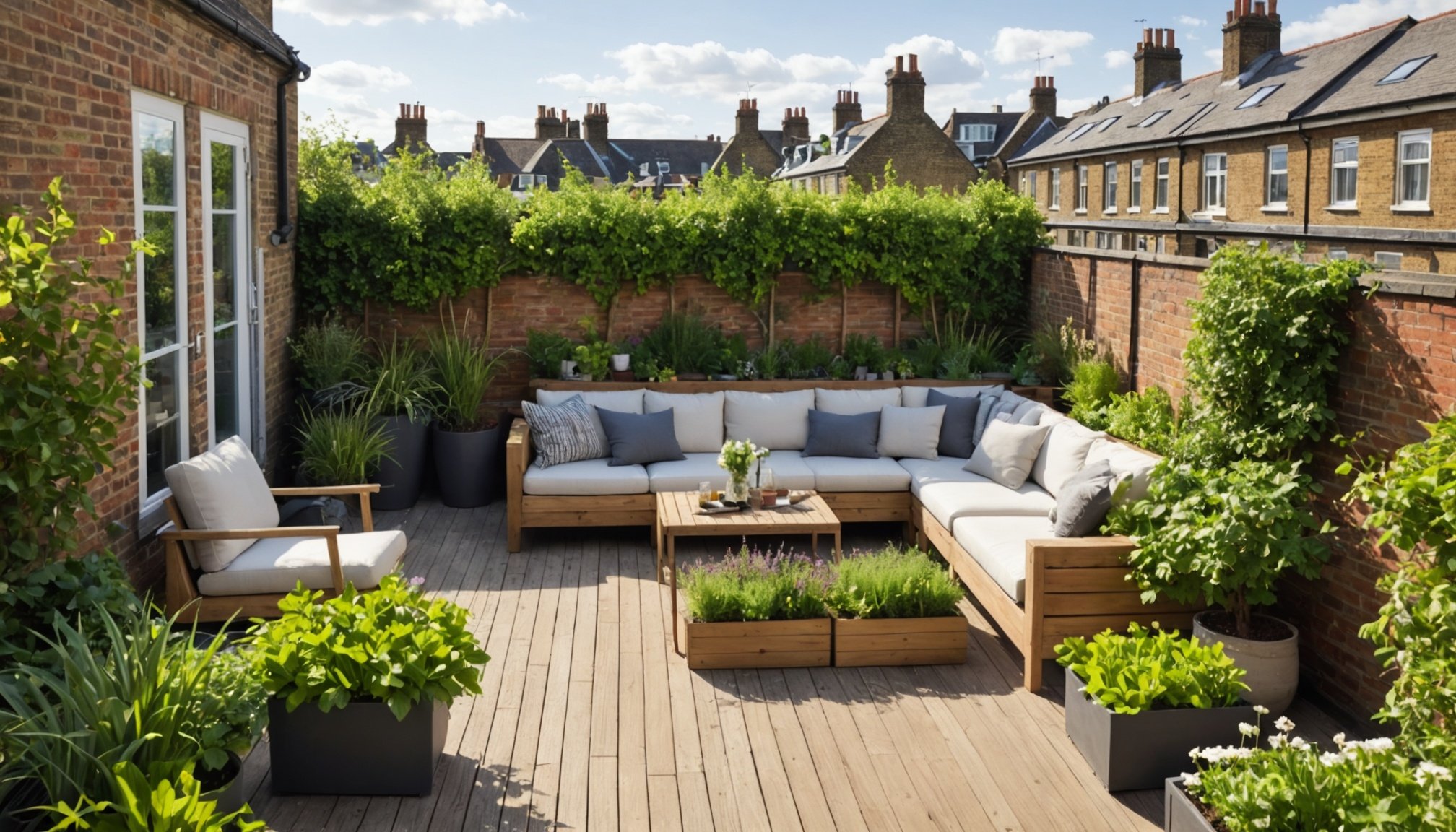Rooftop gardening can transform your London terrace into a serene sanctuary. Imagine vibrant plants thriving in a low-maintenance environment that enhances both aesthetics and relaxation. This guide offers practical tips for creating your oasis, focusing on easy-care plants and smart design choices. Enjoy the benefits of fresh air and greenery without the stress of traditional gardening. Discover how to cultivate a flourishing terrace, perfect for unwinding after a long day. Let’s explore how effortless and rewarding rooftop gardening can truly be.
Planning Your Rooftop Garden
Embarking on a rooftop garden planning journey requires meticulous consideration of several factors. Begin by assessing your terrace space and layout. This step involves measuring your area and understanding its unique characteristics, such as sunlight exposure, wind patterns, and access points. These elements significantly influence your urban gardening choices, from plant selection to placement.
Sujet a lire : Step-by-Step Guide to Installing an Electric Vehicle Charging Station at Your UK Home
Next, familiarize yourself with local building regulations and weight limits. Many urban areas have specific codes governing rooftop use, which can affect your terrace design. Understanding these regulations ensures your garden is safe and compliant. Weight restrictions are particularly crucial; the combined weight of soil, plants, and containers must not exceed your roof's capacity.
Defining your garden goals is the final step in effective rooftop garden planning. Are you aiming for a space of aesthetics and relaxation, or is food production your priority? Your objectives will guide your plant selections and design choices. For instance, if relaxation is your goal, consider incorporating seating areas and ornamental plants. Conversely, if food production is a priority, focus on selecting edible plants that thrive in your climate. By carefully planning, you can create a thriving, enjoyable rooftop garden that meets your needs and complements your urban lifestyle.
A découvrir également : Unlocking Hidden Potential: Creative Ways to Maximize Under-Stair Storage in Your Portsmouth Townhouse
Selecting Easy-Care Plants
Choosing the right plants is crucial for a successful rooftop garden, especially in an urban setting like London. The city's climate, characterized by mild temperatures and frequent rainfall, is conducive to a variety of low-maintenance plants. When selecting plants, consider those that thrive in both sunlight and shade, as rooftop gardens often experience varied light conditions.
For urban gardening, plants such as lavender, sedum, and ferns are excellent choices. Lavender is not only drought-resistant but also attracts pollinators, enhancing biodiversity. Sedum, a succulent, is perfect for sunny spots and requires minimal watering. Ferns, on the other hand, flourish in shaded areas, adding lush greenery to your garden.
Suitable plants for London should also be resilient to wind, a common rooftop challenge. Hardy plants like thyme and ornamental grasses can withstand gusty conditions while providing texture and movement. For beginners, consider starting with herbs like mint and rosemary, which are forgiving and versatile.
In summary, when selecting plants for your rooftop garden, prioritize those that are easy to care for and adaptable to London's unique climate conditions. This approach ensures a thriving and sustainable green space.
Designing Your Rooftop Oasis
Crafting a rooftop garden design involves transforming your terrace into a functional and visually appealing space. Begin by creating distinct zones for relaxation, dining, or gardening. This not only maximizes the utility of your space but also enhances the overall terrace aesthetics. For instance, allocate a corner with comfortable seating for leisure, while dedicating another area to a dining setup for alfresco meals.
Incorporating vertical gardening is an excellent way to utilize limited space efficiently. Consider installing wall planters or trellises to grow climbing plants, which add greenery without occupying valuable floor space. Additionally, container gardening offers flexibility in plant placement and is ideal for urban settings.
To further enhance your garden layout, focus on using color and texture. Select plants with varied foliage and blooms to create visual interest. Ornamental grasses, flowering shrubs, and colourful pots can add layers of depth and vibrancy to your garden.
By thoughtfully designing your rooftop oasis, you not only create a personal retreat but also elevate the aesthetic appeal of your urban environment.
Maintenance Tips for Busy Lifestyles
Maintaining an urban garden can be daunting, especially with a busy schedule. However, adopting low-maintenance gardening techniques can simplify the process significantly. Start with a simple watering routine. Install a drip irrigation system or use self-watering pots to ensure consistent moisture levels. These tools reduce the need for daily attention, making garden maintenance more manageable.
Feeding your plants doesn't have to be time-consuming. Opt for slow-release fertilizers, which gradually nourish your plants over time, minimizing the frequency of application. This approach is ideal for those with hectic lifestyles, ensuring your plants receive the nutrients they need without constant intervention.
Seasonal maintenance tasks are crucial for a thriving garden. In spring, focus on pruning and removing dead foliage to encourage new growth. During summer, monitor for pests and diseases, taking prompt action if needed. Autumn is the time to prepare your garden for winter, mulching plants to protect them from cold temperatures.
Investing in quality tools can further ease urban garden care. A sturdy pair of gloves, a multi-purpose trowel, and a reliable watering can are essentials. These resources, combined with strategic planning, can transform garden upkeep into a more efficient, enjoyable task.
Budget-Friendly Gardening Solutions
Creating a budget rooftop garden is not only feasible but also an exciting challenge. Start by sourcing plants and materials wisely. Local plant swaps, nurseries, and online marketplaces often offer affordable gardening options. Look for sales or discounts on plants that suit your climate, ensuring cost-effective gardening strategies.
Consider incorporating DIY ideas for garden features and furnishings. Repurpose items like old pallets or crates to build planters and seating. This approach not only saves money but also adds a personal touch to your garden. For example, wooden pallets can be transformed into vertical gardens or rustic benches, enhancing your space's functionality and charm.
Exploring community gardening resources is another excellent strategy. Many urban areas have community gardens that provide support and shared resources. Joining such networks can offer access to tools, seeds, and advice from experienced gardeners. These resources can significantly reduce costs and offer valuable insights into maintaining a thriving garden.
By implementing these affordable gardening techniques, you can create a beautiful, functional rooftop garden without breaking the bank. Embrace creativity and community support to maximize your garden's potential while keeping expenses low.
Overcoming Urban Gardening Challenges
Urban gardening, particularly on rooftops, presents unique challenges that require innovative solutions. Wind exposure is a common issue, especially in cities like London. To combat this, consider installing windbreaks such as trellises or screens. These not only shield plants but also create a microclimate, reducing temperature variations. Selecting wind-resistant plants, like ornamental grasses or hardy herbs, can further bolster your garden's resilience.
Temperature variations can also affect plant health. Rooftops may experience extreme heat or cold, impacting plant growth. Use mulch to regulate soil temperature and retain moisture. Additionally, choose plants adapted to London's climate, ensuring they can withstand these fluctuations.
Managing pests and diseases is crucial in a rooftop setting. Regularly inspect plants for signs of trouble and employ natural remedies, such as neem oil or insecticidal soap, to address issues without harming the environment. Companion planting, like pairing marigolds with vegetables, can deter pests naturally.
Engaging with local gardening communities offers invaluable support. These groups provide advice, share resources, and foster a sense of community among urban gardeners. By connecting with others, you can gain insights and tips tailored to your specific urban gardening challenges.











